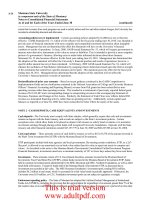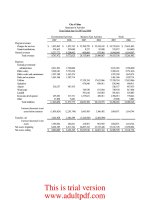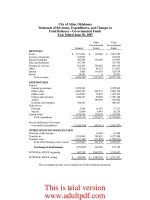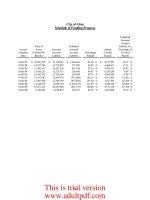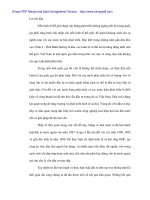Pit Exercises - June 2020 - Ace.pdf
Bạn đang xem bản rút gọn của tài liệu. Xem và tải ngay bản đầy đủ của tài liệu tại đây (270.24 KB, 11 trang )
EXERCISE 1 – DETERMINE TAXABLE AND NON-TAXABLE INCOMES
Mr Hieu Minh is a 40-year-old Vietnamese, who has been relocated back to Vietnam
after serving a five-year secondment in the US with VGC Inc. VGC Inc is the parent
company of VGC Co, a foreign invested company in Vietnam.
On his return to Vietnam on 1 April 2019, Mr Minh entered into an employment contract
with VGC Co. His annual remuneration package for 2019 includes the following (all
amounts are for his employment period in Vietnam in 2019, unless specified otherwise):
– Salary: VND400 million per month.
– Bonus: a fixed 13th month’s salary, pro-rata for the employment time during the year,
plus three months’ salary for meeting all his performance criteria in 2019.
– Relocation allowance in cash: VND200 million (one-off payment).
– Medical insurance fee for 2019 purchased by VGC Inc (with a foreign insurer having
no presence in Vietnam but allowed to carry out ad-hoc insurance operations in
Vietnam): VND20 million.
– Voluntary life insurance fee for 2019: VND100 million paid by VGC Co to Bao Viet
(an authorised insurance company operating in Vietnam). Mr Minh will only receive the
accumulated insured amount upon his retirement or the termination of his employment.
– Car (for transportation from his apartment to his work place and vice versa): hired by
VGC Co for VND15 million per month.
– Uniform allowance: VND15 million in cash.
– Two return air fares for his personal travel to the US to visit his girlfriend: VND40
million.
The personal income tax on his income in Vietnam will be borne by Mr Minh.
Required:
(a) State the personal income tax (PIT) treatment, including the tax payment
requirements, where applicable, of a non-accumulated insurance fee and an
accumulated voluntary life insurance fee paid by an employer direct to the insurer.
(b) Calculate (in VND millions) Mr Hieu Minh’s taxable and non-taxable income in
Vietnam in the year 2019.
EXERCISE 2 – DETERMINE PIT LIABILITY ON EMPLOYENT INCOME, REAL
PROPERTY TRANSFER
Mr Thinh Phan is a 35-year-old Vietnamese citizen. He has a full-time employment as a
manager with TAC Co and has also signed a part-time employment contract with KNT Co
for the delivery of soft skills training courses. Both TAC Co and KNT Co are Vietnamese
companies.
Details of the income received by Mr Phan from the two companies in 2019 are as follows:
Salary
Training allowances
Personal income tax
Employee insurance
contributions
TAC
Co
VND55 million/month
VND96 million
Borne by employer
Borne by Mr Phan
KNT
Co
VND10 million/month
VND360 million
Borne by employer
N/A
Mr Phan has a son, Van Phan, who is 16 years old. From January 2020, Van has been
enrolled to study in a secondary school in Australia. In order to fund Van’s tuition fees,
in 2019 Mr Phan sold an apartment for VND5,200 million. He had purchased the
apartment in 2015 for VND4,000 million as an investment and it was never his sole
house. It was agreed in the sales contract that the personal income tax (PIT) incurred
from the transaction would be borne by Mr Phan but that the buyer would be
responsible for declaring and paying the tax. The sales contract was effective from 1
November 2019, however, the registration procedures were not completed by the buyer
until 20 December 2019, when the buyer settled the payment for the apartment in full.
Required:
(a) Calculate (in VND millions, rounded to one decimal) Mr Thinh Phan’s taxable
income and personal income tax (PIT) liability in respect of his employment
income for the year 2019.
(b) Explain, by reference to the relevant provisions, when Mr Thinh Phan would
be subject to tax on the sale of his apartment and calculate his PIT liability in
respect of the sale in the year 2019.
EXERCISE 3 – DETERMINE PIT LIABILITY ON EMPLOYMENT INCOME,
ROYALTY
Mr Tony Phan, previously resident in Vietnam, is 38 years old and holds Australian
citizenship. From 1 April 2019, he was employed as chief executive offcer (CEO) of
NSV Co, the Vietnamese subsidiary of Next Start Co, a company in Australia.
Tony’s gross remuneration for his employment with NSV Co is as follows:
– Monthly salary: USD30,000.
– Fixed bonus: USD60,000 for 12-months’ employment or pro-rata.
– Variable bonus: up to USD120,000, depending on group and NSV Co’s performance,
to be determined and paid in 2020.
At the commencement of his employment, NSV Co also gave Tony the company’s
executive well-being fitness membership card. This cost NSV Co an amount of
USD120,000 for a period of 18 months.
In Tony’s leisure time he develops artificial intelligence (AI) systems. In 2019, Tony
completed one AI system, in his own time, which could significantly boost the
operational efficiency of both NSV Co and Next Start Co. Next Start Co wants to pay
Tony, via NSV Co, an amount of USD10 million for acquiring the licence to use and
further develop his AI system.
Since the commencement of his employment with NSV Co in April 2019, Tony has
been present in Vietnam along with his wife, Huyen Tran, a 30-year-old Vietnamese
tax resident, and their two children: a five-year-old boy and a two-year-old girl.
Throughout that time the family has been living in a villa which Huyen inherited from
her parents. As this resulted in a saving of accommodation costs for NSV Co, the
company paid Tony and Huyen a monthly home allowance of USD6,000 in cash. Tony
used half of this allowance to pay for kindergarten fees for their children.
Note: You should ignore any social, health or unemployment insurance contributions
which may be applicable.
Required:
(a) Calculate the taxable income and personal income tax (PIT) liability of Mr
Tony Phan in Vietnam in the calendar year 2019.
(b) Briefly discuss the treatment for PIT purposes of the amount of USD10 million
which Next Start Co may pay Tony to acquire the artificial intelligence licence,
assuming the licence is acquired during Tony’s employment with NSV Co in
Vietnam.
EXERCISE 4 – DETERMINE DEPENDENT RELIEFS, PIT TREATMENT OF
ROYALTY
Mr Simon Samson, a 52-year-old South African, arrived in Vietnam on 15 March
2019 following an invitation to become a permanent teacher for VSU, an international
school in Vietnam, for the period to December 2024. VSU successfully registered
Simon’s personal tax code and other necessary dependant registrations for personal
income tax (PIT) purposes on 31 March 2019.
Simon spent the remainder of 2019 in Vietnam. On a trip to visit an orphanage in the
South, he adopted Luong Le, a one-year-old Vietnamese boy, as his son. He
completed the procedures for adoption and started to raise Luong Le from 10 August
2019. Luong Le offcially became a dependant of Simon from 31 August 2019.
Simon has a daughter, Lauren, who is 19 years old. At the time Simon moved to
Vietnam, Lauren was studying at a university in South Africa. In September 2019, she
came to Vietnam to live with Simon and study at an international university in
Vietnam. Lauren has no income in the year 2019.
From May 2019, VSU signed a contract with a voluntary insurance fund which is
allowed to operate in Vietnam for Simon. According to this contract, VSU and Simon
contributed VND2·5 million and VND0·8 million per month, respectively.
In December 2019, Simon donated VND60 million to a qualifying charity fund. After
arriving in Vietnam, Simon started to write a book about his experiences with the
culture in Vietnam, and he signed a contract with Alone World, a foreign publisher,
for publishing this book. According to this contract, the total royalty will be
USD60,000. In 2019, Alone World paid Simon the full amount of the royalty in two
instalments of USD30,000 each.
Required:
(a) Calculate (in VND millions rounded up to the nearest one decimal) all the
possible deductions from taxable income which Mr Simon Samson is entitled to
for personal income tax (PIT) purposes during the year 2019.
(b) Briefly explain the tax treatment of a royalty received by a resident individual
and calculate (to the nearest VND million) the PIT liability, if any, incurred by
Mr Simon Samson on the royalty income received from Alone World in the year
2019.
EXERCISE 5 – DETERMINE PIT LIABILITY ON CASHING SHARES AWARD
Mr Nghia Phan, who is 45 years old and a Vietnamese citizen, is the general director of
HMCP JSC (HMCP) a company listed on the Vietnamese stock market. According to
his labour contract with HMCP, Mr Nghia Phan’s monthly gross income is VND300
million (covering all benefits in cash and in kind and all taxable). He is also entitled to
incentives based on the performance of the company.
At the end of 2018, HMCP offered Mr Nghia Phan a ‘cashing shares award’ scheme as
an appendix to his labour contract, by which he would receive a nominal award of 1·5
million shares of HMCP (with no dividend and voting rights). On 31 December 2019,
HMCP would pay him an ‘award’ equal to the difference between the share price at the
beginning of 2019 (of VND12,000 per share) and that on 30 December 2019. In 2019,
HMCP made a substantial profit and the share price on 30 December 2019 had
increased to VND20,000 per share.
The board of directors was very happy with Mr Nghia Phan’s performance in 2019 and
they are considering offering him additional incentives as follows:
– Option 1: a special cash bonus of VND4,800 million, payable immediately on 31
December 2019; or
– Option 2: a cash bonus of VND1,600 million, plus 150,000 shares to be awarded
with full rights to receive dividends, payable immediately on 31 December 2019. The
board plans to make a dividend payment for 2019 of VND1,000 per share in April
2020.
Mr Nghia Phan has three dependants, being his children. His compulsory insurance is
calculated based on the cap of VND26 million per month.
Required:
(a) Describe the personal income tax (PIT) treatment of (1) the ‘cashing shares
award’ scheme and (2) the shares awarded under Option 2 above.
(b) Calculate (in VND millions) Mr Nghia Phan’s PIT liability in Vietnam in the
year 2019 under Option 1 above.
EXERCISE 6 – DETERMINE PIT LIABILITY ON TRANSFER OF SHARES
In 2015, Mr Tuy Nguyen, a 50-year-old Vietnamese national, purchased 1,000,000
shares in DBX, a company listed on the Vietnamese stock exchange, for VND12,000
per share. The nominal price of each DBX share is VND10,000. In 2019, Mr Tuy had
the following transactions with regard to DBX’s shares:
– On 1 January 2019, he received 200,000 shares as a scrip dividend (i.e. a dividend
paid in the form of shares).
– On 1 April 2019, he sold 150,000 shares for VND18,000 per share.
– On 20 December 2019, he sold 400,000 shares for VND20,000 per share.
Required:
Calculate the personal income tax (PIT) which Mr Tuy Nguyen had to pay
during the year 2019 when he sold his DBX shares.
EXERCISE 7 – DETERMINE PIT LIABILITY ON EMPLOYMENT INCOME AND
PRIZES
Mr Dung Tien is 22 years old and is a Vietnamese football player. He plays for the TH
Football Club (THFC) in Vietnam and the national youth team of Vietnam. He entered
into a two-year term labour contract with the THFC management company from the
beginning of January 2017 and received the following remuneration package for his first
year of service under the contract:
– Salary: VND45 million per month;
– Performance incentives: based on six months’ salary if THFC is the champion of the
league, or three months’ salary in other cases; and
– One-off sign-on payment of VND2,400 million for his two-year contract of services
(payment to be made at the time the contract is signed).
The remuneration stated in the contract is gross of personal income tax (PIT). Dung is
responsible for his share of insurance contribution expenses. THFC was ranked second in
the league in 2017, which lasted from January to September 2017.
From October to December 2017, Dung played for the national youth team where, in
addition to his THFC salary, he received a gross monthly allowance of VND15 million,
which was paid to THFC who then paid it to Dung. By late 2017, the national youth team
had made an historic achievement in an Asian football competition. For his excellent
contribution towards this achievement, Dung received:
1. a cash prize of VND1,320 million, accompanied by a certifcate of reward issued by the
government authorities in charge of sports in Vietnam;
2. a car with a market value of VND800 million from a car assembling company; and
3. free-of-charge flights for one year up to a value of VND500 million from VNA, an
airline in Vietnam.
Dung was single in 2017. He lived with his father who is 65 years old, and his mother
who is 60 years old. Neither of his parents had any income in 2017.
According to a recent ruling issued by the tax authorities, the contractual one-off sign-on
payment shall be taxed in the same manner as employment income.
Required:
(a) Briefly explain the tax treatment for each of the three prizes received by Mr
Dung Tien during 2017.
(b) Calculate (in VND millions, rounded to one decimal) Mr Dung Tien’s taxable
employment income, and his total personal income tax (PIT) liability from all
income sources for the year 2017.
EXERCISE 8 – DETERMINE PIT LIABILITY ON CAPITAL TRANSFER
Mr Hung Duong and Ms Hien Duong are brother and sister. In 2013, they inherited a
piece of land of 500 square metres in the city downtown from their parents, for which
they have duly settled all personal income tax (PIT) obligations for the inheritance. There
was no specific indication as to the ratio of ownership in their parents’ will or any other
documents.
At the beginning of 2016, they decided to sell the land, and entered into an agreement
with an individual buyer on 1 March 2016. The agreed contractual price was VND200
million per square metre (being the market price at the time of transfer), and the seller was
obliged to handle the tax filing and payment. The contract was effective from 15 March
2016 and Mr Hung Duong registered the change in ownership on 30 March 2016.
Payments were fully settled on 1 April 2016.
After the sale of the land, on 15 April 2016, Mr Hung Duong used all of the cash received
plus 500,000 shares of ABC Co, a listed company on the HNX Stock Exchange, to
contribute capital into HD Co, a limited liability company. At the time of contribution, the
market price of the ABC Co shares was VND15,000 per share. The value of the capital
contribution was agreed based on the actual cash contribution and this market value for
the ABC Co shares. On 1 September 2016, Mr Hung Duong sold the capital contribution
in HD Co to Mr Nam, a Vietnamese individual, for VND68,000 million. The market price
of the ABC Co shares was unchanged.
Required:
(a) Determine the taxing date for personal income tax (PIT) purposes of the land sale
made by Mr Hung Duong and Ms Hien Duong, according to Circular 92/2015.
(b) State the basis on which the taxable income on the land sale will be allocated
between Mr Hung Duong and Ms Hien Duong and calculate (in VND millions) the
PIT liability, if any, payable by Mr Hung Duong.
(c) Briefly explain the tax treatment of the capital contribution made to HD Co by
Mr Hung Duong on 15 April 2016 and calculate (to the nearest VND millions) the
PIT liability incurred, if any.
(d) Calculate (to the nearest VND millions) the PIT liability incurred by Mr Hung
Duong, if any, in respect of the sale of the capital contribution in HD Co on 1
September 2016.
EXERCISE 9 – DETERMINE PIT LIABILITY ON EMPLOYMENT INCOMES
Mr Nobi Takeshi, a 50-year-old Japanese, was assigned by his parent company, Daisu Co
Ltd, to its Vietnamese subsidiary, Daisu Vietnam Co Ltd (Daisu Vietnam), from 1
January 2013 to 15 July 2014. He is treated as a tax resident in Vietnam in 2014. Mr
Nobi’s adopted son, Suneo, moved to Vietnam with him on 1 January 2013. Suneo
became 18 years of age on 1 May 2014. Mr Nobi made compulsory insurance
contributions in Japan, equivalent to VND8 million per month throughout his time in
Vietnam. In April 2014, Mr Nobi donated VND50 million to a qualified centre which
cares for handicapped children.
Mr Nobi married his interpreter, Ms Ngoc Le, on 1 February 2014. Ms Ngoc Le is 38
years old and divorced. She has two children of her own from her previous marriage,
Tung aged 15 years and Quang, aged 10 years. Ms Ngoc Le also has a handicapped sister
with no income, whom she has directly cared for during the last two years.
When Ms Ngoc Le got married, she terminated her employment with Daisu Vietnam and
became a housewife. On the termination she received VND36 million, being the
settlement of her salary for January 2014. She did not have any income from February
2014 onwards. When working with Daisu Vietnam, Ms Ngoc Le entered into a voluntary
pension contribution agreement with a pension fund which operates in accordance with
the Ministry of Finance’s regulations. She continued the agreement and contributed
VND1·2 million per month until 15 July 2014 when she and Mr Nobi left Vietnam and
returned to Japan. After their departure, Ms Ngoc Le kept her Vietnamese citizenship
until 31 December 2014. On their marriage, Ms Ngoc Le agreed with Mr Nobi that he
would claim all dependant reliefs/deductions available to them according to the
regulations.
Required:
Calculate all the possible personal income tax (PIT) deductions from taxable income
which:
(a) Mr Nobi Takeshi is entitled to in 2014;
(b) Ms Ngoc Le is entitled to in 2014.
EXERCISE 10 – DETERMINE PIT LIABILITY ON EMPLOYMENT INCOMES
Hung Phan, 30 years old, is a manager with DLCVN, an international law firm. He has
been with the firm for six years. With effect from 1 April 2013, the firm decided to
relocate Hung from Hanoi to Ho Chi Minh City due to work requirements. His family,
including his pregnant wife, Trang Pham, joined him. The firm rented the family a small
apartment in Phu My Hung at a rental of VND15 million per month from 1 April 2013.
Trang Pham used to work in a bank with a gross salary of VND24 million per month but
with no other benefits, however, following the move to Ho Chi Minh City she decided to
take temporary unpaid leave for her pregnancy. On 1 July 2013, she gave birth to twins,
Trung Phan and Hieu Phan. Trang only returned to work on 1 January 2014. During the
year 2013, Hung received the following from DLCVN:
– Salary: VND32 million per month when he was in Hanoi, increased by 12·5% on his
relocation to Ho Chi Minh City.
– Overtime payments: 200 hours overtime for the whole year at 200% of his normal
salary of which 20 hours were worked when he was in Hanoi and the remaining 180
hours equally each month when he was in Ho Chi Minh City. DLCVN has an average of
160 standard working hours per month.
– Bonus: one month’s salary received in January 2013 and another month’s salary on 21
December 2013.
– Membership of a gym club in Ho Chi Minh City. The registration fee of the gym club
is VND2 million per month and this was paid in cash to Hung Phan.
DLCVN bears all personal income tax with regard to the employment income of its
employees, however, the employees are responsible for their own compulsory insurance
contributions.
Required:
In respect of Hung Phan’s personal income tax (PIT) for the year 2013:
(a) Calculate his total and monthly taxable income before housing allowance, his
monthly housing allowance, his monthly personal deductions/reliefs, and his total
non-taxable income, separately for each of the two periods:
– 1 January to 30 June 2013; and
– 1 July to 31 December 2013.
(b) Calculate the total annual PIT liabilities on his taxable income.

